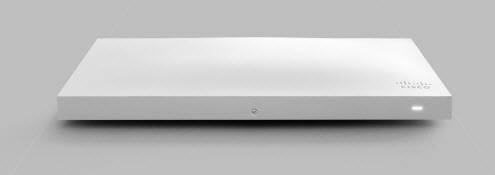To help organizations meet infrastructure demands while managing complex networks, Cisco’s newly formed Cloud Networking Group  announced the Cisco Meraki MR34, the first 100 percent cloud-managed 802.11ac access point. This solution, which marries the current 802.11n Wi-Fi standard with innovations in security and management, allows businesses to support more users on the network, provide highly secure access, increase wireless speeds, and easily manage their wireless networking from the cloud.
announced the Cisco Meraki MR34, the first 100 percent cloud-managed 802.11ac access point. This solution, which marries the current 802.11n Wi-Fi standard with innovations in security and management, allows businesses to support more users on the network, provide highly secure access, increase wireless speeds, and easily manage their wireless networking from the cloud.
The 802.11ac standard is gaining momentum as market transitions such as cloud computing and high-bandwidth applications like video, IT mobility and bring-your-own-device (BYOD) are fueling demand for greater speed and bandwidth from wireless networks. In addition, broadband carriers continue to look to offload traffic onto WiFi networks where possible to reduce the skyrocketing demand on their networks.
The 802.11ac standard—also called 5G WiFi—will bring significant improvements over 802.11n. Along with the faster speeds, it also will allow for greater network capacity, which will mean more devices can be connected to the network without impinging too much on performance. In addition, 802.11ac will work in two bands—the 2.4GHz band that WiFi now works in, and the 5GHz band, where users can get a higher data rate.
The IEEE is still months away from ratifying the 802.11ac standard, but vendors already are running out of products that support the standard. In addition, the WiFi Alliance in June announced it was beginning to certify devices—including routers, adapters, smartphones, notebooks, tablets and other computing systems—based on the draft standard.
Cisco is aggressively pursuing the 802.11ac market. Most recently, company officials in April release the first of the company’s 802.11ac modules for its Aironet 3600 Series access point, enabling businesses to migrate to the new WiFi standard without having to invest in an entirely new appliance.
Now Cisco is introducing the Meraki MR34, which not only comes with 802.11ac support, but also with new management and security capabilities, according to Biswas, who came to Cisco last year after the vendor bought Meraki, the company he founded that made cloud-based wireless network management tools.
The Meraki acquisition gave Cisco another avenue into the midmarket space, which the company sees as a strong growth area, he said. Biswas said the midmarket represents about a $5 billion opportunity for Cisco.
Highlights and Features of Cisco Meraki MR34:

- High-Speed 802.11ac Wi-Fi with Application Traffic Shaping–The MR34 provides a 1.75 Gbps data rate–nearly double the capacity of existing 802.11n access points. It supports more mobile devices and high-bandwidth applications compared to legacy networks. The MR34 features unique capabilities that allow users to prioritize traffic from business-critical applications like voice and video conferencing, while blocking unwanted traffic such as peer-to-peer file sharing.
- Dedicated Security Radio–Built for the needs of security-conscious environments such as retail, healthcare, and financial services, the MR34 includes a unique third radio that is dedicated to scanning the surrounding Radio Frequency (RF) environment for strong protection against wireless attacks and interference.
- Cloud-Based Features–The MR34 includes powerful cloud-based features; from multi-site management to Facebook login for brand exposure, location analytics, and integrated mobile device management (MDM). The MR34 is part of a complete cloud-managed solution, new features continually delivered from the cloud.
- Seamless Migration from Legacy 802.11 a/b/g/n Networks–The MR34 allows operators of legacy 802.11 a/b/g/n networks to easily adapt to the new 802.11ac standard. Featuring zero-touch provisioning, the MR34 is automatically configured remotely via the cloud. Support of mixed 802.11ac and 802.11 a/b/g/n networks, compatibility with legacy clients, and backward compatibility with legacy 802.3af Power over Ethernet (PoE) enable gradual migration of legacy networks.
Software-Centric Opportunities for Partners
The introduction of the MR34 is consistent with Cisco’s strategy to offer more software-centric solutions that create new business opportunities for system integrators and value-added resellers (VARs). With the MR34 access point, channel partners can gain subscription-based software revenue, and access to midmarket and enterprise customers seeking a high capacity cloud-based solution. When managed through the Cisco Meraki Managed Services Dashboard, the MR34 provides partners with a new cloud-based service, drastically reducing the time to market and resulting in minimal capital costs.
The new Cisco Meraki MR34 will be available later this summer, starting at $1,399. It also includes a lifetime warranty.
Supporting Quotes
Sanjit Biswas, vice president and general manager, Cloud Networking Group, Cisco
“Enterprises and midmarket businesses alike are increasingly looking to the cloud to simplify their infrastructure needs. Cisco’s new cloud managed 802.11ac wireless access point is our step towards helping our customers embrace the influx of mobile devices and better support bandwidth-intensive apps. Moreover, this new product furthers Cisco’s strategy of offering software-centric solutions to streamline IT operations and empower customers to capture new business opportunities.”
Craig Mathias, principal at Farpoint Group
“With the rollout and adoption of 802.11ac now growing at a rapidly accelerating pace, businesses ranging from small to midsize to large enterprises are now upgrading 802.11g and .11n wireless networks to meet increasing demands for both throughput and capacity. The newly announced MR34 wireless access point from Cisco addresses this need for significant improvements in performance, and also offers backwards compatibility to earlier Wi-Fi technologies, a Managed Services dashboard, location analytics, and a third radio that can detect and mitigate interference, vulnerabilities and attacks. 802.11ac is not just about speed, but sophisticated products now have the ability to improve the functionality and value of business Wi-Fi across the board.”
—News and Review Resources from Cisco’s newsroom & eweek.com
More Related Cisco Reviews
802.11ac Wi-Fi vs. the 802.11n
Wi-Fi Alliance Announces 802.11ac Certification
Antenna Product Portfolio for Cisco Aironet 802.11n Access Points
